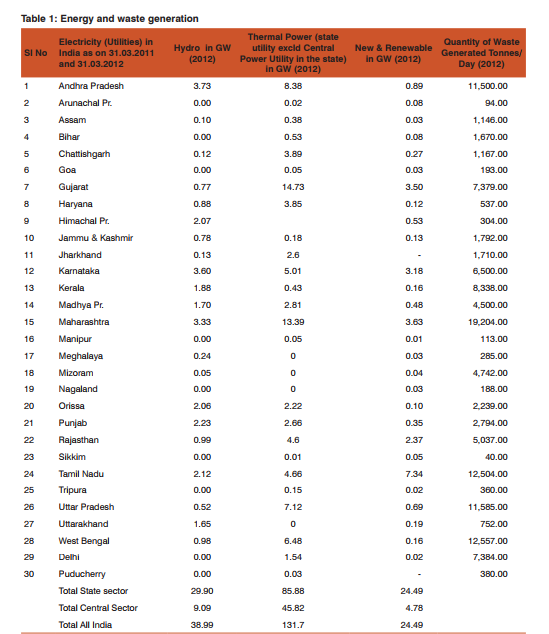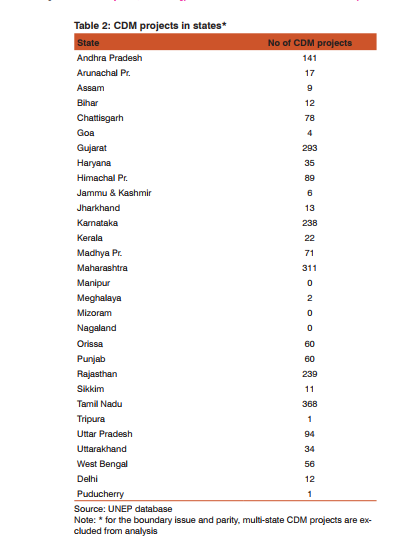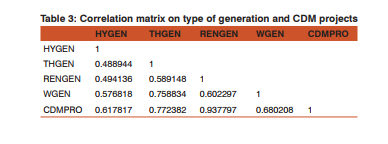IJCRR - 8(2), January, 2016
Pages: 14-18
Print Article
Download XML Download PDF
CLIMATE JUSTICE,CLEAN ENERGY AND CARBON MARKET IN INDIA: A SUB-NATIONAL ANALYSIS
Author: Ashok Kumar Singha
Category: Healthcare
Abstract:Purpose: The purpose of this paper is to analyse the increasing attention of the public on issues relating to climate change and role of clean energy in containing the emission and ensuring equity and justice in the carbon market. Approach and Methodology: The key problem in analysing the issue of climate justice at the subnational level flows from the fact that, the inputs for generations in the state are given by nature be it hydro-power, wind or thermal. Even solar irradiation varies from state to state. Based on this factor endowment states convert this opportunity to have a certain kind of generation mix. Fewer still convert this clean energy generation to a carbon market opportunity. The paper analyses the generation mix of the states and their investment in converting them in to CDM opportunity in the interest of climate justice in moderating emission. Findings: It has been observed that the renewable energy generation is highly correlated with CDM project investment at the state level. Moreover states with higher thermal generation too do make effort to moderate emission by investing in CDM projects. Originality/Value: The paper hitherto ventures in to the uncharted area of the climate justice at the sub-national level within the boundary of a nation. So far the debates focussed on climate justice in the context of developing and developed nations. This paper tries to see what kind of incentive be there to develop a domestic carbon market in the interest of climate justice in the field of energy generation like it has been done in the context of energy efficiency.
Keywords: Emission, Carbon market, Climate justice
Full Text:
INTRODUCTION
Energy is critical for a nation's development. The per capita energy consumption in India is 0.78 MWh as per International Energy Agency (IEA)energy outlook. Currently, India’s per capita energy consumption is one-third of the global average. About one in five of Indian population is living without electricity. Moreover the kind of life style maintained in rural India shows energy demand per capita in 2040 would still be about 40% below the world average. In addition energy intensity for India too have declined during 1990-2012. Overall the drop has been large for China, Russia and India than for the United States (US), the European Union (EU) or Japan1 . This clearly shows transition of India to commit to a low carbon path and the journey has already begun. In 1 https://www.iea.org/newsroomandevents/graphics/2014-08-19-energy-consumption-per-capita-and-energy-intensity.html accessed 30 Dec 2015 the climate justice view point one has to argue whether we keep countries in energy poverty while other countries keep occupying the carbon space without showing less ambition for emission cut.
This has been clearly observed from the intent of the developed countries like US, Japan, Australia in their Intended Nationally Determined Contribution (INDC) submissions. These countries have shown below par ambitions with scant attention to climate justice and equity. India in her Intended Nationally Determined Contribution aims at achieving a 30-40 percent share of renewables in the total energy mix by 2030. A large part of it is likely to come from the ambitious solar mission announced as part of National Action Plan on Climate Change (NAPCC). As per an analysis Indiahas to have an installed capacity of 175 gigawatts (GW) of renewable power capacity by 2022. The country also commits to reduce its emissions intensity per unit GDP by 33 to 35 percent below by 2030 from 2005 baseline year.
However, India has clearly made it conditional that it would do so with international assistance. In this context the role of carbon finance which is enshrined under the Kyoto protocol assumes lots of significance. The purpose of this paper is to analyse the increasing attention of the public on issues relating to climate change and role of clean energy in containing the emission and ensuring equity and justice in the carbon market at the state level in India.
CLIMATE JUSTICE FRAMEWORK IN RECENT LITERATURE
Climate justice dialogue has been in international climate change discourse for more than two decades. However, with the increased importance and public attention on vulnerability of earth due to climate change has raised the level of this debate.
Climate Justice Concept and its dilemma at the sub-national level
Under the United Nation Framework Convention on Climate Change, climate justice is embedded in the Common But Differential Responsibility (CBDR) principles. This is based on the premise of "Polluter pays". Considering the fact that global North (developed countries) industrialised earlier and faster enabled them to occupy large part of the carbon space and left little for the south remains a contentious issue. Most literature on equity and climate justice focusses on northsouth relations (Mathur et.al. 2014). However, the concept of climate justice has become a movement (Bond, 2013) as many in global north and south and both recognise the threat of climate change and need to advance this agenda. There is also strident appeal for paying the climate debts. While it is easier to negotiate climate justice issue from historical responsibility and burden sharing perspective among the countries, it is difficult to do that within the boundary of a country amongst various states.
The inputs for generations in the state are given by nature be it hydro-power, wind or thermal. Even solar irradiation varies from state to state. Based on this factor endowment principle, states convert this opportunity to have a certain kind of generation mix. Fewer still convert this clean energy generation to a carbon market opportunity. This paper tries to analyse this phenomenon and see whether a carbon market mechanism in the framework of climate justice feasible within a country considering the fact that there is very high stake and slow progress in these negotiations (Chatterton, 2013).
Kyoto protocol principles and climate justice
Kyoto protocol ratified by India draws heavily on climate justice agenda even though it accounts for only 12% of the global emission reduction. While many sceptics economically call Clean Development Mechanism (CDM) under the protocol asa zero sum game, it actually triggers reduction above the business-as-usual scenario in the developing countries. In some sense it tries to incentivise counties (developing countries) who have right to emit to not to do so and developed countries (polluters with historical responsibility) to pay for it. The key principles of United Nation Framework Convention on Climate Change (UNFCCC) (as per the Article 3 of the convention) is based on intra2 (current generation) and intergenerational (future generation) equity.
This include the following (a) Equity and Common but Differentiated Responsibilities and Respective Capabilities (b) Full Consideration for Developing Country Needs and Circumstances (c) Precautionary principle i.e. the lack of scientific certainty should not prevent Parties from taking cautionary measures if the likelihood of serious damage to the environment exists. (d) Right to Sustainable Development (e) Cooperate to Promote Supportive and Open Economic System (Oberthür, 1999). The backers of Kyoto protocol give credit to the flexibility and its market based approach and rigorous methodology. The detractors criticise the distributive and sometime opaque method of transfer of climate finance to genuine stakeholders. In this paper, discussion has been on the energy generation and opportunity in the states in India and how Carbon Market are related at the sub-national level.
MATERIAL AND METHODS
The generation data was collected form the states to understand the current generation mix. To ensure the boundary issue central utility share has been excluded and only state generation capacity has been included in computation. For the CDM project data, the UNEP CDP pipeline data was used. It is important to examine the fact that Clean Development Mechanism (CDM) projects are not always formulated based on generation type and depends on several factors and even several methodologies. For the analysis Hydro-power generation (HYGEN), Thermal Power generation (THGEN), Renewable Power Generation (RENGEN) and waste to energy projects (WGEN) projects were correlated with CDM projects (CDMPRO) in the states. Correlation procedure in STATA software was used for developing the correlation matrix.
RESULTS
The table 1 shows the generation mix in the states. Thecorrelation matrix in Table 2 shows how CDM projects (as in open database of UNEP) are distributed across the states. Table 3 shows how these are correlated with different types of generation in the states. Correlation matrix was generated using STATA software. It shows that the renewable generation (RENGEN) is highly correlated (0.937) with the number of registered CDM projects implying states with high renewable power investment trends are likely to have more CDM projects.
The interesting fact is that, the states with thermal energy investments too come second (0.772) in terms of the CDM project conversion. This points towards the emission moderation in these states from other kinds of energy efficiency projects or generally better investment climate for CDM. The relative higher correlation of waste generation (WGEN) and CDM projects (0.68) over hydro (HYGEN) projects (0.617) could be due to the higher profitability of waste management related CDM projects as compared to the hydro power generation projects. Apart from that the CDM Executive Board too have rejected many large hydro projects due to negative externalities related to displacements.
DISCUSSION
It is important to note that the states have their own state specific conditions (factor conditions) based on the resource endowment (i.e. coal baring states for thermal generation and states with higher amount of water and necessary gradient for hydro-power, etc.) for having a particular energy mix. Based on their exposure and ability the states would structure emission reduction projects and access carbon market. This study tries to identify where such correlation exists. Since equity and climate justice is the basis for carbon market, this study attempts to analyse whether such a principle is mirrored at the sub-national level.
As explained in the results areas with large quantity of number thermal power generation have too attempted to undertake emission reduction projects. This attempt mirrors equity and climate justice even though it may not be distributional (from high emission states to low emission states, but certainly such actions ensures emission reduction at aggregate level within country boundary or moderated emission within the state boundary than business as usual).
CONCLUSION
One of the critical pointers from this analysis is the fact that the states having higher number of renewableprojects are more likely to tap in to carbon market opportunity for the incentives that these projects provide in terms of Certified Emission Reduction (CER) revenue. In case of states where large number of thermal powerproject are there and they tap in to carbon market that is because of the disincentive that they foresee from the higher emission.
They do invest in CDM projects in anticipation of offsets or from the point of view of emission moderation not to be seen as fall guys. In many cases coal bearing states like Odisha, Chhatishgarh (where large number of thermal power projects are there) do create awareness for other industries to invest in CDM so that the carbon foot print of the state is reduced. This points to a scenario where domestic market may evolve if there is a good price clearing market for carbon credit. This would ensure some degree of climate justice both nationally and internationally.
ACKNOWLEDGEMENT
The author acknowledges Prof. N C Kar for his valuable suggestions and guidance. Author also acknowledges the immense help received from the scholars whose articles are cited and included in references of this manuscript. The author is also grateful to authors / editors / publishers of all those articles, journals and books from where the literature for this article has been reviewed and discussed.



References:
1. Bond, P. Politics of climate justice. Paralysis above, movement below. University of Kwa Zulu Natal Press, Cape Town2012.
2. Chatterton, P., Featherstone, D., and Routledge, P. Articulating climate justice in Copenhagen: Antagonism, the commons, and solidarity. Antipode 2013;45(3), 602-620.
3. Mathur, V. N., Afionis, S., Paavola, J., Dougill, A. J., and Stringer, L. C. Experiences of host communities with carbon market projects: Towards multi-level climate justice. Climate Policy 2014;14(1), 42-62.
4. Oberthür, S., and Ott, H. E. The Kyoto Protocol: international climate policy for the 21st century. Springer 1999.
5. Pandey, A., Basu, S., and Sarkar, R. India Infrastructure Report 2010: Infrastructure Development in a Law Carbon Economy. Oxford 2015.
6. Prouty, A. E. Clean Development Mechanism and Its Implications for Climate Justice, The. Colum. J. Envtl. L.2009; 34, 513.
7. Purohit, P., Michaelowa, A. CDM potential of SPV lighting systems in India. Mitigation and Adaptation Strategies for Global Change 2008;13(1), 23-46.
8. Rabe, B. G. Beyond Kyoto: Climate change policy in multilevel governance systems. Governance2007; 20(3), 423-444.
9. Rai, V., and Victor, D. G. Climate change and the energy challenge: a pragmatic approach for India. Economic and Political Weekly2009;44(31).
10. Singha, A. K., Nayak, S. K., Kar, N. C., Tripathy, S., Sahoo, B. K. Anticipating and Managing an Unwelcome Guest: Climate Smart Approach in Disaster Management. In Land and Disaster Management Strategies in Asia2015; Springer India. (pp. 155-168).
11. Singha, A. K., Majumdar, S., Saha, A., Hazra, S. Deconstructing Debate on the National Action Plan on Climate Change at the State Level: A Case Study of Meghalaya State, India. Governance Approaches to Mitigation of and Adaptation to Climate Change in Asia 2013;131.
|






 This work is licensed under a Creative Commons Attribution-NonCommercial 4.0 International License
This work is licensed under a Creative Commons Attribution-NonCommercial 4.0 International License